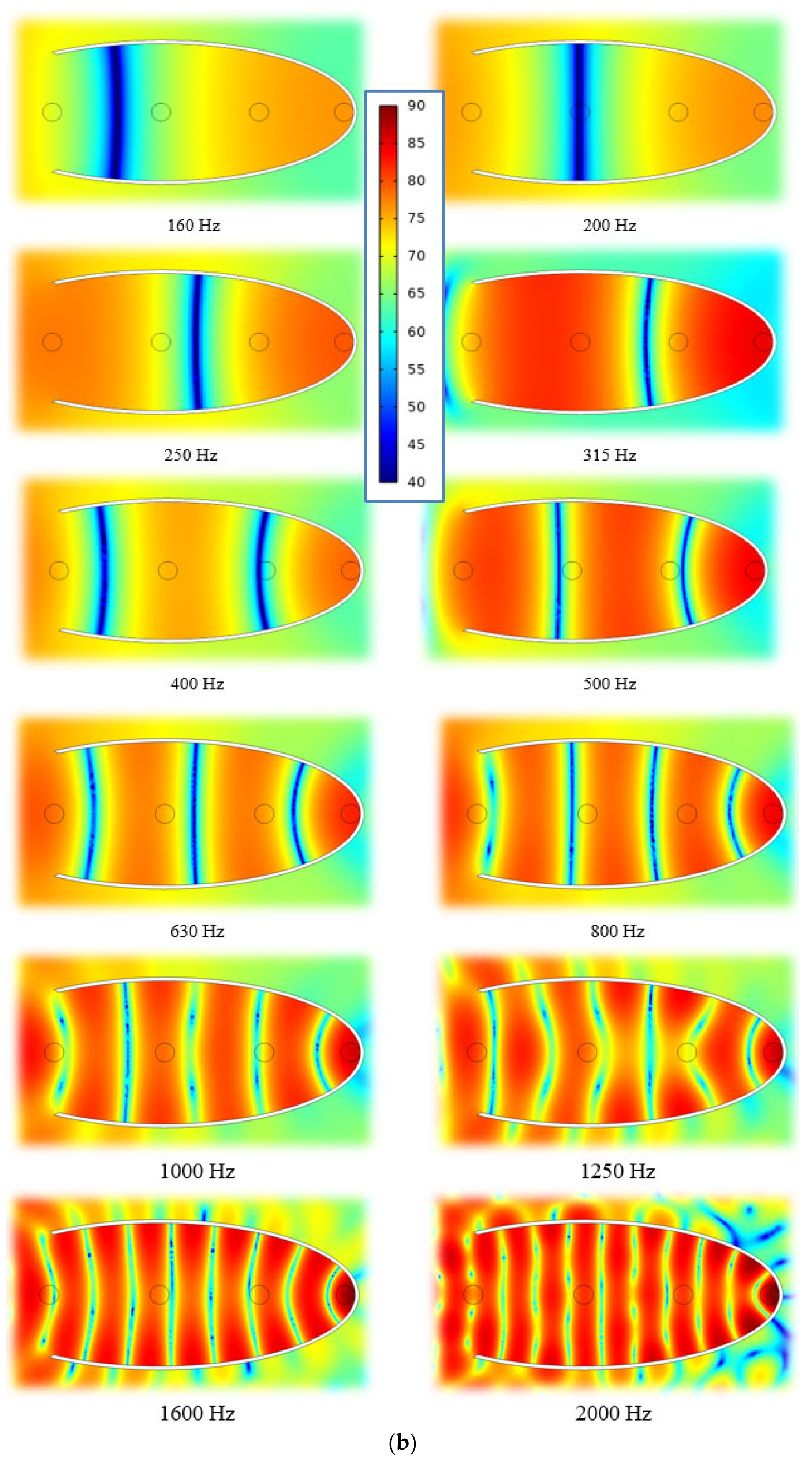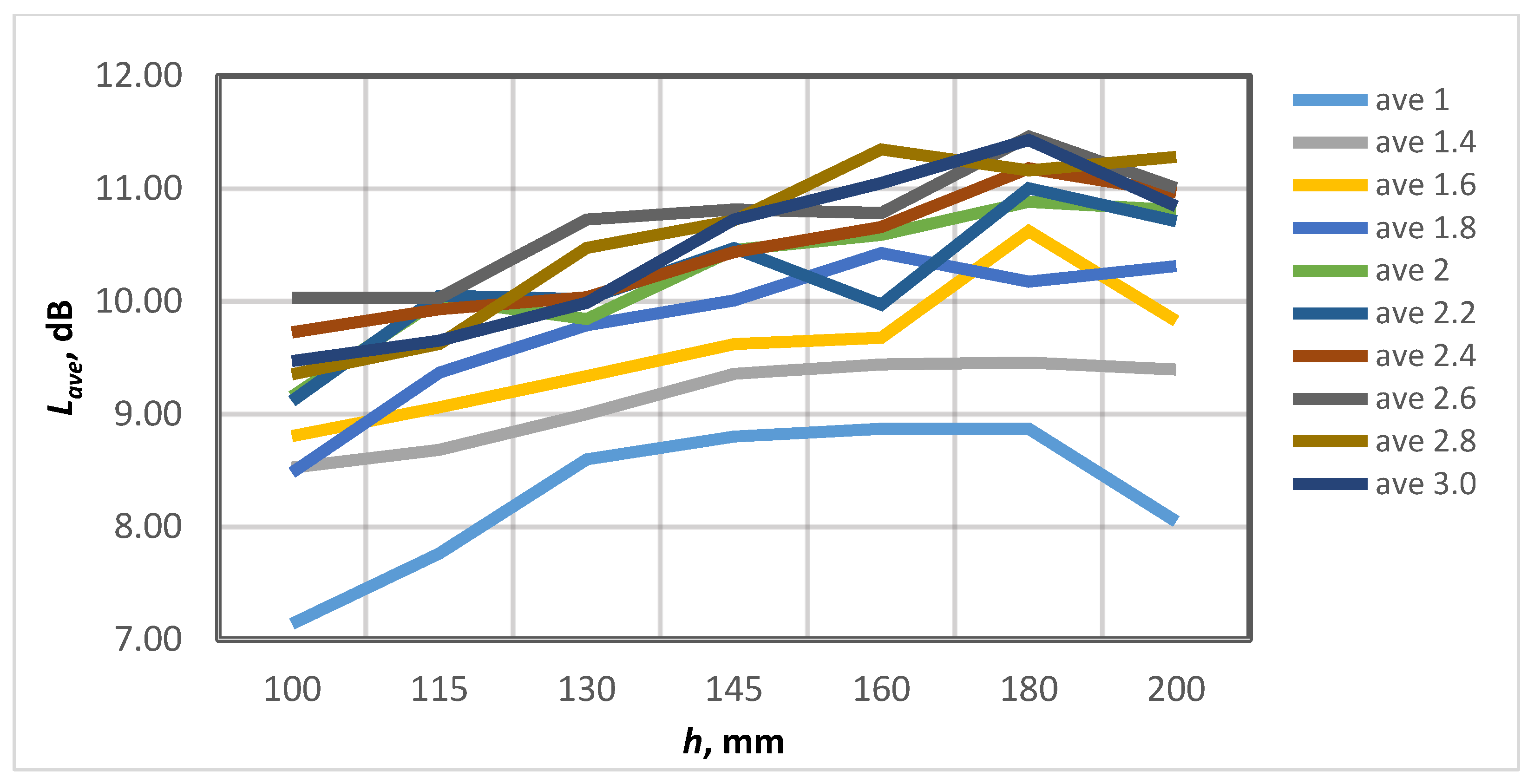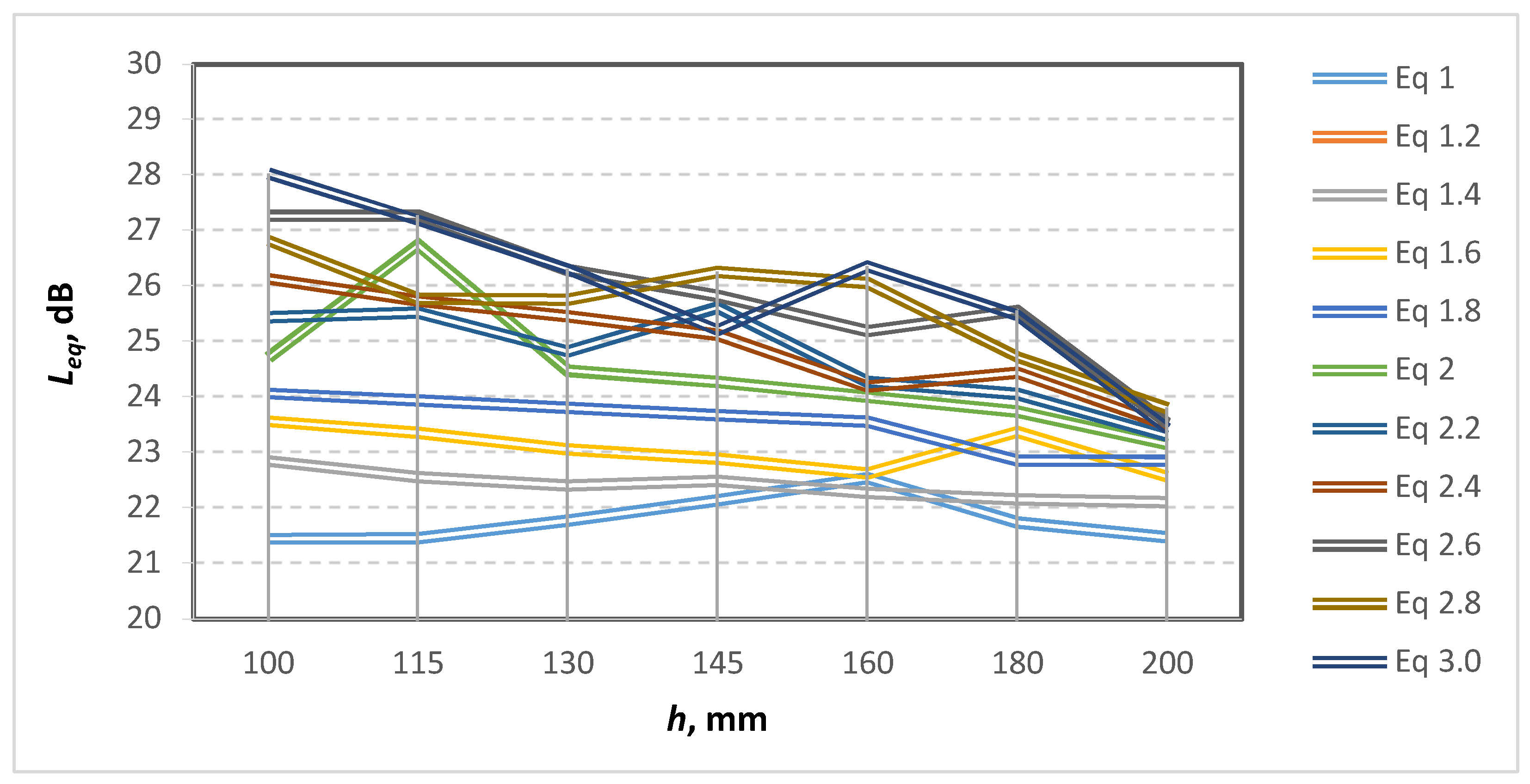Investigation of the Change of Acoustic Pressure in an Element of Acoustic Barrier with an Elliptical Shape
Abstract
1. Introduction
2. COMSOL Model
2.1. Model Description
2.2. Model Parameters
2.3. Methodology
- Modelling of the studied object.
- o
- Selection of the study type/simulation analysis/;
- o
- Modelling of the acoustic barrier element;
- o
- Modelling of the acoustic space;
- o
- Defining the material characteristics of objects;
- o
- Setting the boundary conditions of the acoustic space;
- o
- Selection of the type of acoustic pressure source;
- o
- Defining the meshing of the model (Figure 2);
- o
- Selection of a third-octave frequency range for research from 63 Hz to 2000 Hz ({63, 80, 100, 125, 160, 200, 250, 315, 400, 500, 630, 800, 1 × 103, 1.25 × 103, 1.6 × 103, 2 × 103} Hz, Figure 2).
- It is accepted Ls = const = 0.6 m, for all study options;
- The dimension for r2 = b = 200 mm is selected;
- The options for changing the opening of the cross-section of the acoustic element are selected /h = 2·b·sin(α/2), α = 180, 112, 90, 71, 58, 48, 40, 33°/; (a/b = 2);
- The distance between the center of the element and the opening is determined (Lc);
- The variants of the relative change of a/b are selected: 1.0; 1.2, 1.4, 1.6, 2.0, 2.2, 2.4, 2.6, 2.8, and 3.0;
- Defining the areas where the change in the sound pressure level will be tracked when the frequency of the acoustic noise changes:
- The number of areas is determined;
- The location of the areas is determined;
- The size of the areas is determined.
- 8.
- Defining the areas and parameters for assessment (Domain Probe 1, Domain Probe 2, Domain Probe 3, Domain Probe 4, and Domain Probe 5).
- 9.
- The results of simulation studies for the different sizes of h and a/b are recorded in a table. The following are determined with them:
- The sound pressure level in area 3 without an acoustic element in third octaves;
- The sound pressure level by third octaves in the defined areas with an acoustic element (Figure 1);
- 10.
- Processing of results.
- The results of simulation studies for the different variants of the sector angle and the different sizes of the elliptical sector are recorded in a table. The difference is determined:
- 11.
- Analysis of the results and conclusions of the research.
3. Results
3.1. Average Sound Pressure Level in Four Characteristics Areas at Third-Octave Frequencies
3.2. Sound Pressure Level Distrbution inside the Acoustic Barrier Element with Additional Element at Different Frequencies
3.3. Analysis of the Results
4. Conclusions
Author Contributions
Funding
Institutional Review Board Statement
Informed Consent Statement
Data Availability Statement
Acknowledgments
Conflicts of Interest
References
- Yuan, M.; Zioing, C.; Luo, J.; Chou, X. Recent Developments of Acoustic Energy Harvesting: A Review. Micromachines 2019, 10, 48. [Google Scholar] [CrossRef] [PubMed]
- Song, C.; Zhao, J.; Ma, X.; Zhang, M.; Yuan, W.; Yang, F.; Wang, Z.; Zhang, X.; Pan, Y. Multi-frequency sound energy harvesting using Helmholtz resonators with irradiated cross-linked polypropylene ferroelectret films. AIP Adv. 2021, 11, 115002. [Google Scholar] [CrossRef]
- Choi, J.; Jung, I.; Kang, C.-Y. A brief review of sound energy harvesting. Nano Energy 2019, 56, 169–183. [Google Scholar] [CrossRef]
- Kralov, I.; Terzieva, S.; Ignatov, I. Analysis of methods and MEMS for acoustic energy harvesting with application in railway noise reduction. Rom. Rev. Precis. Mech. Opt. Mechatron. 2011, 3, 56–62. [Google Scholar]
- Kralov, I. New solution for transport and industrial noise protection through reflective noise barriers. In Proceedings of the 9th International Scientific Conference on Aeronautics, Automotive and Railway Engineering and Technologies, BulTrans, Sozopol, Bulgaria, 11–13 September 2017; Volume 133. [Google Scholar]
- Kralov, I.; Nedelchev, K. Lowering the noise level in the transport flows through reduction of the traffic barrier reflected noise. IOP Conf. Ser. Mater. Sci. Eng. 2019, 618, 012051. [Google Scholar] [CrossRef]
- Liang, H.; Hao, G.; Olszewski, O. A review on vibration-based piezoelectric energy harvesting from the aspect of compliant mechanisms. Sens. Actuators A Phys. 2021, 331, 112743. [Google Scholar] [CrossRef]
- Hu, Z.; Yang, C.; Cheng, L. Acoustic resonator tuning strategies for the narrowband noise control in an enclosure. Appl. Acoust. 2018, 134, 88–96. [Google Scholar] [CrossRef]
- Zhang, H.; Zhu, Y. Omnidirectional Ventilated Acoustic Barrier. Appl. Phys. Lett. 2017, 111, 203502. [Google Scholar] [CrossRef]
- Noh, H. Acoustic energy harvesting using piezoelectric generator for railway environmental noise. Adv. Mech. Eng. 2018, 10, 1–9. [Google Scholar] [CrossRef]
- Wang, Y.; Zhu, X.; Zhang, T.; Bano, S.; Pan, H.; Qi, L.; Zhang, Z.; Yuan, Y. A renewable low-frequency acoustic energy harvesting noise barrier for high-speed railways using a Helmholtz resonator and a PVDF film. Appl. Energy 2018, 230, 52–61. [Google Scholar] [CrossRef]
- Hosseinkhani, A.; Younesian, D.; Eghbali, P.; Moayedizadeh, A.; Fassih, A. Sound and vibration energy harvesting for railway applications: A review on linear and nonlinear techniques. Energy Rep. 2021, 7, 852–874. [Google Scholar] [CrossRef]
- Qi, S.; Oudich, M.; Li, Y.; Assouar, B. Acoustic energy harvesting based on a planar acoustic metamaterial. Appl. Phys. Lett. 2016, 108, 263501. [Google Scholar] [CrossRef]
- Guo, H.; Wang, Y.S.; Wang, X.; Xu, C. Investigation on acoustic energy harvesting based on quarter-wavelength resonator photonic crystals. Adv. Mech. Eng. 2018, 10, 1–13. [Google Scholar] [CrossRef]
- Ji, X.; Yang, L.; Xue, Z.; Deng, L.; Wang, D. Enhanced Quarter Spherical Acoustic Energy Harvester Based on Dual Helmholtz Resonators. Sensors 2020, 20, 7275. [Google Scholar] [CrossRef] [PubMed]
- Li, B.; You, J.H.; Kim, Y.-J. Low frequency acoustic energy harvesting using PZT piezoelectric plates in straight-tube resonator. Smart Mater. Struct. 2013, 22, 55013. [Google Scholar] [CrossRef]
- Li, B.; Laviage, A.J.; You, J.H.; Kim, Y.-J. Harvesting low-frequency acoustic energy using quarter-wavelength straight-tube acoustic resonator. Appl. Acoust. 2013, 74, 1271–1278. [Google Scholar] [CrossRef]
- Liu, G.-S.; Peng, Y.-Y.; Liu, M.-H.; Zou, X.-Y.; Cheng, J.-C. Broadband acoustic energy harvesting metasurface with coupled Helmholtz resonators. Appl. Phys. Lett. 2018, 113, 153503. [Google Scholar] [CrossRef]
- Kumar, S.; Lee, H.P. The Present and Future Role of Acoustic Metamaterials for Architectural and Urban Noise Mitigations. Acoustics 2019, 3, 590–607. [Google Scholar] [CrossRef]
- Yuan, T.; Chen, F.; Yang, J.; Song, R.; Kong, Y. Novel Circular Plate Acoustic Energy Harvester for Urban Railway Noise. Shock Vib. 2021, 2021, 1–13. [Google Scholar] [CrossRef]
- Nedelchev, K.; Kralov, I. Efficiency improvement of a vibration energy harvesting generator by using additional vibrating system. In Proceedings of the 43rd International Conference on Applications of Mathematics in Engineering and Economics, AMEE 2017, AIP Conference Proceedings, Sozopol, Bulgaria, 8–13 June 2017. [Google Scholar]
- Aleksandrova, M. Spray deposition of piezoelectric polymer on plastic substrate for vibrational harvesting and force sensing applications. AIMS Mat. Sci. 2018, 5, 1214–1222. [Google Scholar] [CrossRef]
- Nedelchev, K.; Kralov, I.; Gieva, E.; Ruskova, I. Modeling of acoustic barrier for energy harvesting applications having placed additional element having circle shape with COMSOL. J. Balk. Tribol. Assoc. 2022, 28, 1–14. [Google Scholar]
- Gieva, E.; Ruskova, I.; Nedelchev, K.; Kralov, I. COMSOL modelling of acoustic barrier for energy harvesting applications. J. Environ. Prot. Ecol. 2022, 23, 20–29. [Google Scholar]
- Nedelchev, K.; Kralov, I. Study of the change of acoustic pressure in an acoustic barrier element in the form of a logarithmic spiral. J. Balk. Tribol. Assoc. 2022, 28, 51–63. [Google Scholar]
- COMSOL. Available online: www.comsol.com (accessed on 1 May 2022).
- Li, D.; Hu, M.; Wu, F.; Liu, K.; Gao, M.; Ju, Z.; Zhao, J.; Bao, A. Design of tunable low-frequency acoustic energy harvesting barrier for subway tunnel based on an optimized Helmholtz resonator and a PZT circular plate. Energy Rep. 2022, 8, 8108–8123. [Google Scholar] [CrossRef]







| Parameter | Symbol | Value |
|---|---|---|
| Distance between the source and the opening part of the ellipse along the X-axis | LS | 0.6 m. |
| Distance between p. C (area 2) and the center of area 1 | LR1 | a-(tp+ rM) m |
| Distance between p. C (area 2) and the center of area 3 | LR3 | h/tan(α) m |
| Distance between p. C (area 2) and the center of area 4 | LR4 | LR1/2 m |
| Radius of measurement areas | rM | 0.025 m. |
| Relative length of the major axle | a/b | 1.0; 1.2; 1.4; 1.6; 2.0; 2.2; 2.4; 2.6; 2.8 and 3.0 m |
| Length of the small axle | b | 0.2 m. |
| Location of measuring area 2 relative to point C/coincides with point C/ | - | 0 m. |
| Wall thickness of the pipes | tp | 10 mm. |
| Central corner of the cut part of the section | α | 180, 112, 90, 71, 58, 48, 40, 33°. |
| Height of the cut part of the section | h | 2·b·sin(α/2) m. |
| Radius of the acoustic space | Ra | 1.5Ls+LR3+LR1 m |
| Radius of the source | Rs | 0.03 m. |
| Sound pressure of the noise source | - | 1 Pa |
| h, mm | 100 | 115 | 130 | 145 | 160 | 180 | 200 |
|---|---|---|---|---|---|---|---|
| f, Hz | ΔL1, dB | ΔL1, dB | ΔL1, dB | ΔL1, dB | ΔL1, dB | ΔL1, dB | ΔL1, dB |
| 63 | 3.49 | 3.35 | 3.15 | 3.02 | 2.82 | 2.52 | 2.13 |
| 80 | 10.89 | 10.56 | 10.20 | 9.80 | 9.33 | 8.50 | 6.33 |
| 100 | 10.65 | 10.14 | 9.63 | 9.10 | 8.51 | 7.53 | 5.08 |
| 125 | 13.09 | 12.22 | 11.44 | 10.70 | 9.95 | 8.79 | 6.05 |
| 160 | 15.07 | 14.50 | 13.71 | 12.86 | 12.01 | 10.84 | 8.54 |
| 200 | 9.77 | 11.11 | 12.26 | 13.09 | 13.44 | 12.95 | 10.46 |
| 250 | 7.29 | 8.40 | 9.45 | 10.44 | 11.37 | 12.47 | 12.48 |
| 315 | 1.61 | 2.80 | 4.04 | 5.37 | 6.82 | 9.04 | 11.48 |
| 400 | 1.54 | 2.37 | 3.16 | 3.95 | 4.76 | 5.99 | 9.29 |
| 500 | 4.90 | 5.39 | 5.85 | 6.27 | 6.70 | 7.31 | 8.63 |
| 630 | 13.22 | 12.80 | 12.13 | 11.37 | 10.60 | 9.66 | 9.34 |
| 800 | 6.97 | 8.32 | 9.60 | 10.69 | 11.50 | 12.00 | 10.80 |
| 1000 | 6.32 | 6.68 | 6.92 | 7.24 | 7.96 | 10.10 | 14.15 |
| 1250 | 8.87 | 10.04 | 11.93 | 14.81 | 16.90 | 12.34 | 6.96 |
| 1600 | -0.96 | 2.60 | 8.93 | 9.09 | 7.28 | 5.05 | 9.51 |
| 2000 | 1.51 | 2.94 | 5.20 | 3.01 | 1.94 | 6.84 | -2.46 |
| Lave | 7.14 | 7.76 | 8.60 | 8.80 | 8.87 | 8.87 | 8.05 |
| Leq | 21.45 | 21.46 | 21.77 | 22.13 | 22.54 | 21.75 | 21.46 |
| h, mm | 100 | 115 | 130 | 145 | 160 | 180 | 200 |
|---|---|---|---|---|---|---|---|
| f, Hz | ΔL1, dB | ΔL1, dB | ΔL1, dB | ΔL1, dB | ΔL1, dB | ΔL1, dB | ΔL1, dB |
| 63 | 14.20 | 14.20 | 12.97 | 11.95 | 10.88 | 8.09 | 5.49 |
| 80 | 25.09 | 25.09 | 22.73 | 21.09 | 19.46 | 19.92 | 14.36 |
| 100 | 18.80 | 18.80 | 19.50 | 20.44 | 20.04 | 19.03 | 12.52 |
| 125 | 4.81 | 4.81 | 6.33 | 8.59 | 10.43 | 14.31 | 13.28 |
| 160 | 1.10 | 1.10 | 1.72 | 2.46 | 3.36 | 5.41 | 13.34 |
| 200 | 3.94 | 3.94 | 4.30 | 4.67 | 5.30 | 6.31 | 9.92 |
| 250 | 13.60 | 13.60 | 11.92 | 10.44 | 9.17 | 8.01 | 9.98 |
| 315 | 4.92 | 4.92 | 6.84 | 9.25 | 12.07 | 12.74 | 6.69 |
| 400 | 8.08 | 8.08 | 7.39 | 6.97 | 6.91 | 7.98 | 12.00 |
| 500 | 6.77 | 6.77 | 8.51 | 10.48 | 11.97 | 11.16 | 11.12 |
| 630 | 12.55 | 12.55 | 12.81 | 11.66 | 10.19 | 10.74 | 10.87 |
| 800 | 11.57 | 11.57 | 11.37 | 10.74 | 10.56 | 11.56 | 11.94 |
| 1000 | 10.58 | 10.58 | 11.85 | 11.53 | 10.87 | 12.38 | 11.68 |
| 1250 | 9.62 | 9.62 | 10.93 | 12.50 | 11.23 | 14.68 | 11.64 |
| 1600 | 8.21 | 8.21 | 12.44 | 10.20 | 9.86 | 10.61 | 10.51 |
| 2000 | 6.68 | 6.68 | 10.03 | 10.08 | 10.25 | 10.49 | 10.77 |
| Lave | 10.03 | 10.03 | 10.73 | 10.82 | 10.78 | 11.46 | 11.01 |
| Leq | 27.27 | 27.27 | 26.29 | 25.82 | 25.20 | 25.55 | 23.52 |
| h, mm | 100 | 115 | 130 | 145 | 160 | 180 | 200 |
|---|---|---|---|---|---|---|---|
| f, Hz | ΔL1, dB | ΔL1, dB | ΔL1, dB | ΔL1, dB | ΔL1, dB | ΔL1, dB | ΔL1, dB |
| 63 | 15.31 | 14.30 | 12.81 | 13.83 | 13.89 | 11.28 | 7.19 |
| 80 | 26.96 | 25.70 | 23.92 | 19.90 | 23.48 | 19.60 | 14.30 |
| 100 | 10.17 | 13.57 | 15.59 | 17.75 | 16.08 | 19.77 | 10.59 |
| 125 | 1.19 | 2.13 | 3.26 | 4.66 | 6.59 | 10.53 | 7.14 |
| 160 | 1.11 | 1.46 | 2.01 | 2.46 | 2.98 | 4.11 | 11.38 |
| 200 | 7.42 | 6.88 | 3.41 | 6.18 | 6.06 | 6.35 | 8.74 |
| 250 | 10.25 | 12.45 | 14.68 | 15.89 | 14.69 | 11.06 | 9.06 |
| 315 | 2.95 | 3.38 | 4.02 | 5.00 | 6.68 | 11.04 | 8.32 |
| 400 | 8.41 | 11.01 | 13.34 | 13.30 | 11.01 | 8.40 | 13.24 |
| 500 | 9.82 | 8.72 | 8.13 | 8.10 | 8.84 | 11.49 | 10.18 |
| 630 | 8.00 | 7.71 | 8.39 | 9.98 | 12.45 | 11.84 | 12.66 |
| 800 | 10.60 | 9.08 | 9.11 | 10.39 | 11.70 | 11.63 | 11.79 |
| 1000 | 10.31 | 12.61 | 11.40 | 10.20 | 11.41 | 11.72 | 14.07 |
| 1250 | 10.41 | 10.47 | 11.38 | 11.62 | 11.42 | 13.16 | 13.09 |
| 1600 | 10.58 | 5.98 | 9.72 | 11.28 | 9.75 | 11.03 | 10.67 |
| 2000 | 8.06 | 9.02 | 8.67 | 11.07 | 9.78 | 9.94 | 11.06 |
| Lave | 9.47 | 9.65 | 9.99 | 10.73 | 11.05 | 11.43 | 10.84 |
| Leq | 28.03 | 27.19 | 26.30 | 25.21 | 26.35 | 25.47 | 23.43 |
Disclaimer/Publisher’s Note: The statements, opinions and data contained in all publications are solely those of the individual author(s) and contributor(s) and not of MDPI and/or the editor(s). MDPI and/or the editor(s) disclaim responsibility for any injury to people or property resulting from any ideas, methods, instructions or products referred to in the content. |
© 2022 by the authors. Licensee MDPI, Basel, Switzerland. This article is an open access article distributed under the terms and conditions of the Creative Commons Attribution (CC BY) license (https://creativecommons.org/licenses/by/4.0/).
Share and Cite
Nedelchev, K.; Gieva, E.; Kralov, I.; Ruskova, I. Investigation of the Change of Acoustic Pressure in an Element of Acoustic Barrier with an Elliptical Shape. Acoustics 2023, 5, 46-56. https://doi.org/10.3390/acoustics5010003
Nedelchev K, Gieva E, Kralov I, Ruskova I. Investigation of the Change of Acoustic Pressure in an Element of Acoustic Barrier with an Elliptical Shape. Acoustics. 2023; 5(1):46-56. https://doi.org/10.3390/acoustics5010003
Chicago/Turabian StyleNedelchev, Krasimir, Elitsa Gieva, Ivan Kralov, and Ivelina Ruskova. 2023. "Investigation of the Change of Acoustic Pressure in an Element of Acoustic Barrier with an Elliptical Shape" Acoustics 5, no. 1: 46-56. https://doi.org/10.3390/acoustics5010003
APA StyleNedelchev, K., Gieva, E., Kralov, I., & Ruskova, I. (2023). Investigation of the Change of Acoustic Pressure in an Element of Acoustic Barrier with an Elliptical Shape. Acoustics, 5(1), 46-56. https://doi.org/10.3390/acoustics5010003






